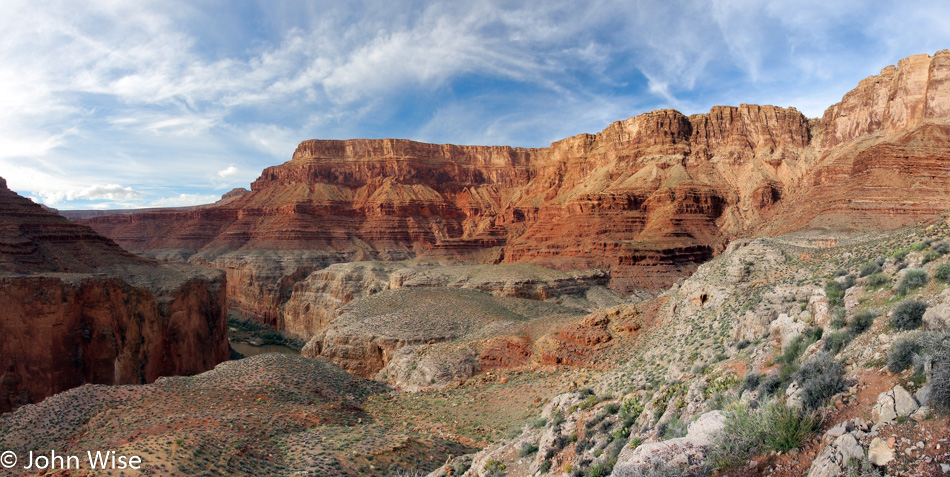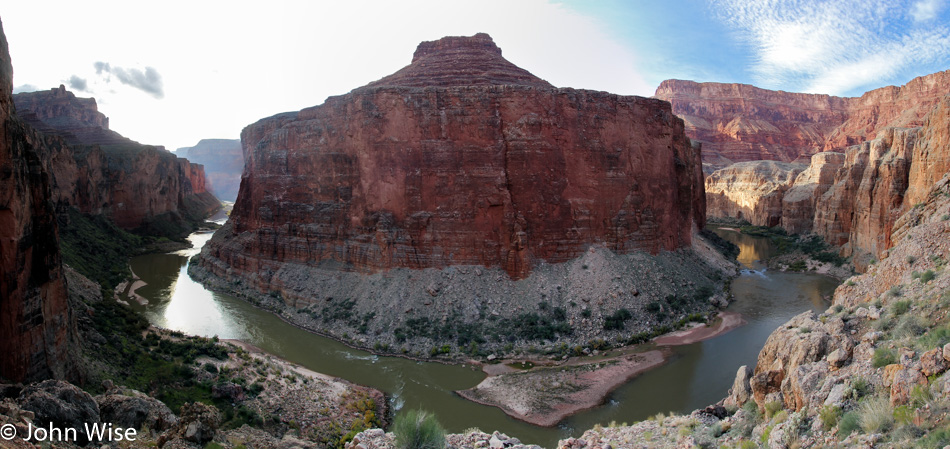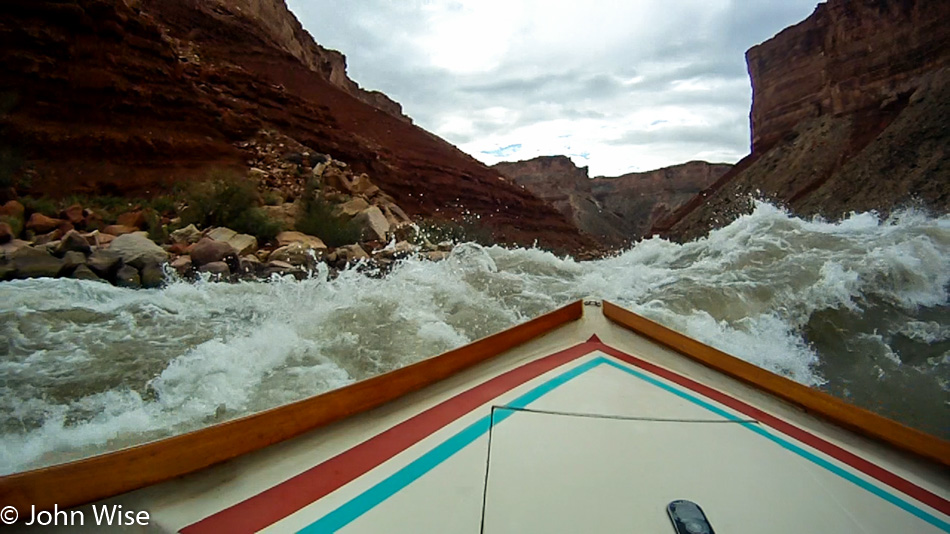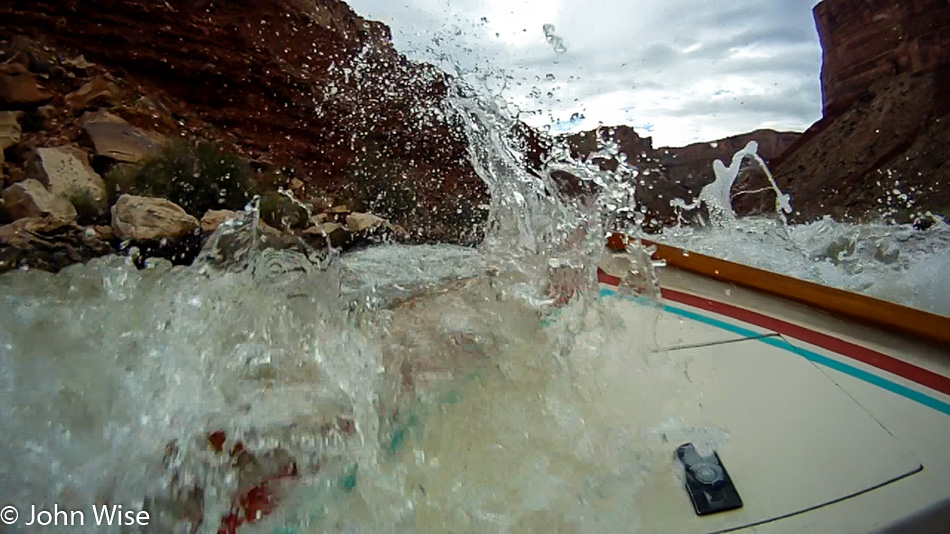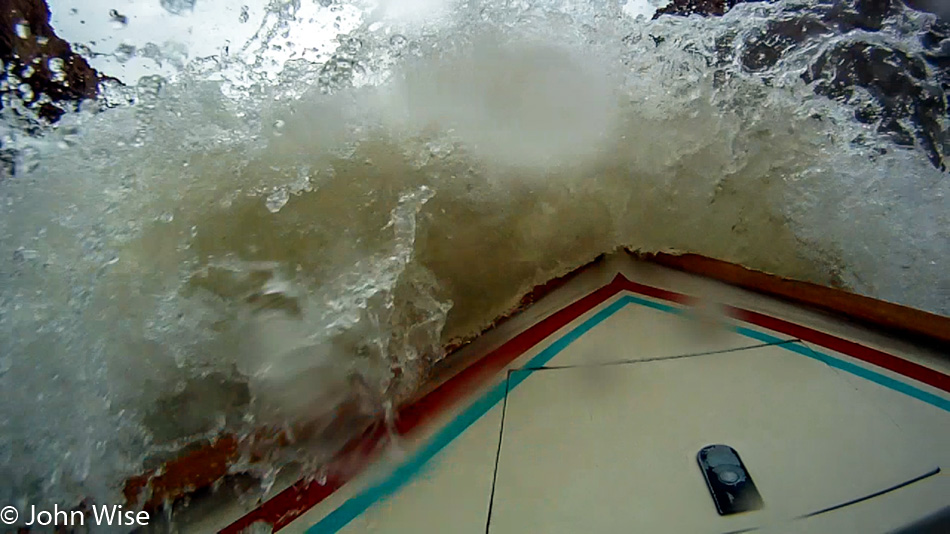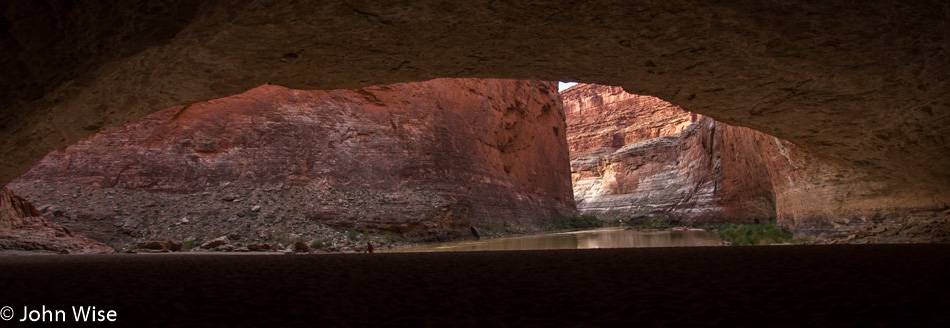
Have I woken to life in The Far Side? Like in the comic, most of the scene is normal. There’s just this one anomaly that brings absurdity to the situation. The peculiarity arresting my attention is a tall bearded cow of the Holstein variety standing upright on two legs instead of down on all four. I am facing its flaming pink udder, sporting four teats that point directly at me. Of all the situations I may have dreamt of prior to this adventure, a man-cow shooting a cyclopean beam of light from its forehead was probably the farthest thing from my mind. And just what is this apparition? A dream, a phantasm, a ghost? No, it is boatman Steve Kenney who has traded his dress for a formfitting Holstein jumpsuit. The next question is surely going to be, why? Because he is making breakfast, that’s why. I beg my wife to grab the camera and take a photo of me on bended knees, suckling the bearded Cyclops cow, but she insists she would die of embarrassment if her husband were to throw himself on another man’s udder. This is not when I wake from a dream; this really is my morning.

In dark shadows of the early day, there’s not a lot to be seen. We must wait for the sun to fill the sky with its brilliance to guide us voyagers who are following this path sliced deep within the Canyon. Until then, we are afforded the luxury of enjoying another cup of coffee with our sunrise. We chat with the boatmen, asking who has empty seats we might claim as ours. Early on, it was suggested that we rotate who we are riding with from day to day to allow us the experience of learning how each boatman responds to the river. Soon, it is bright enough for us to continue rowing with the current, and are underway. We venture out on mostly calm water to a point further downstream, where we will embark on adventures yet to be discovered.

Time spent on the Colorado becomes amorphous, lost in the drift. I wonder if seconds, minutes, hours, or days have passed. Reflecting patterns in dancing ripples under rock folds combine with the change in river speed and the varying color palette to hypnotize my vacating mind. My eyes should have arms and hands skilled in pulling even more of these sights into my memories. I wish for a tool capable of harvesting the magnitude of light bouncing off the surrounding environment and then depositing its wealth directly to the optic nerve, carving a permanent image of what I am seeing. Like an appetite for food, my eyes develop a hunger to see more of more. All the while, as my desire for more escalates, my brain reels under the weight of overwhelming stimulation, forcing the body into stillness from the frantic sense of perpetual awe. Small talk is replaced with big silence.




Less than an hour after putting in on the river, we are pulling off the river. Hike number three starts like the previous ones: fill your water bottles and change out of river shoes into hiking boots for those who prefer that option – the majority of us remain in river shoes while the boatmen hike in flip-flops. Let’s go. From down here, most trails have but one direction – up. And that’s where we take aim. The paths are well-worn from the thousands of pairs of feet trekking through these canyons, but precisely where those trails continue is not always apparent. In a landscape full of bare rocks and boulders, it is easy to lose the way, requiring a quick scramble to reconnect to a thoroughfare that is just 20 or 30 feet away but cannot readily be seen thanks to a lack of cairns or trail markings, leaving us novice hikers wondering where to turn. Some quick calculations and we are again catching up with the group. From the front, instructions are passed back, this time advising caution when grabbing rocks for leverage as fishhook cactus burrs in your fingers are painful reminders that you may not have been listening to valuable warnings.

We hike into a side canyon; our attention focused on the person in front of us while trying to make sure that we’re not holding up anyone following behind. The problem here for those of us wanting to spend time sightseeing is that there is little opportunity to stop and get a good long look at the splendid panoramic scene surrounding us. Our quick elevation gain offers views of the snaking river we are traveling and glimpses into the distance where we are yet to go. Look over your shoulder at these sights too long, and you risk finding yourself stumbling into an injury that might necessitate an airlift from your perch, bringing this part of your adventure to an end. We pay attention and watch our steps and where our hands are placed.


Toward the top of the hill, the ground levels quickly, and in a second, we enter a narrow canyon. At the same moment, the desert fades and is replaced with trees, monkeyflowers, ferns, and a small creek. The desire to look up and downriver from on high fades as new curiosity envelops the senses. What is all this greenery? Why is this oasis right here, and for how long during the year is it so fantastically lush? I want to be here just five minutes in an attempt to see and understand it all. No chance, we have a date with a destination in Saddle Canyon.

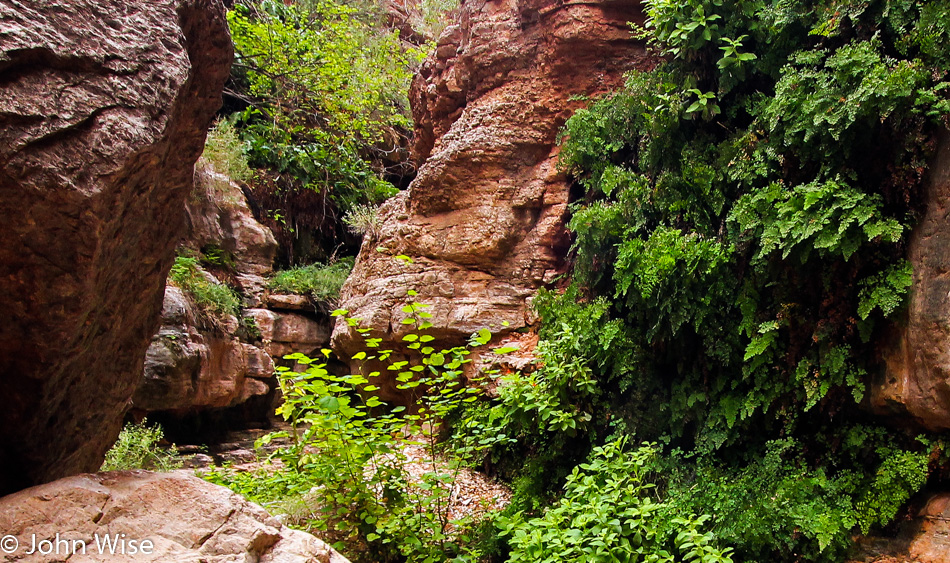
The trail leads us into a slot canyon, allowing us to see close-up the details left, right, and directly in front of us all at the same time. The mind’s eye buckles the knees of perception. Maybe the Grand Canyon is, in reality, a cascade of beauty designed as a cruel hint of what perfection might look like. Here I am again in a state of awe, reduced to a single-word vocabulary of, you guessed it, “Wow.”

The last part of the hike has us passing through a chest-deep pool of cold, murky brown water before coming upon a chockstone. This king-size rock from elsewhere up in the canyon has wedged into the slot and represents a bit of an obstacle for us. The boatmen reassure us that we can all get up here with a little help. A hidden handhold has been carved into the boulder; we are directed where to place one foot, then the other, now grab up there, push off, and if you need to, grab a boatman’s hand.

I am now on the shelf, flanked in intimacy by red sandstone, facing a clear pool and the hanging moss growing up the sides of this exclamation of a waterfall. The rarity of opportunities to witness this tiny hidden corner of our world is not lost on me. Never will it be possible to parade a million people into this shrine of Saddle Canyon. Maybe after the hike, others might feel that this experience is the most natural thing in the world, to be standing below such magnificence, but I must stop and take stock. How many times during my life will I be given this chance to be present in a space narrower than many a sidewalk, where a waterfall tumbles gently before me, performing a delicate concerto of wonder, gracing my ears with the soft rush of falling water, as it dances in the light, tickling my eyes?


As beautiful as it all is, it is not mine; I will not take a bit of it home. Aside from a few photographs. I can invest every sense of awareness at my muster, and still, the power of recollection is a weak recording mechanism. I keep on looking, observing, listening. I feel the cool breeze and step into the shallow water to immerse myself in the experience of having been in Saddle Canyon. I sit here a while, and still, mere seconds after I leave, the fading mental images will spill into uncertainty that such a beautiful place really ever existed, robbing me of the fleeting memories I try to latch onto. Maybe someday I’ll come back? But then, what of the other still unseen corners passed up for a visit to this place? Would they have been as beguiling? And what of this new thought of returning? It’s not really yet a glimmer of possibility, as this was supposed to be a once-in-a-lifetime trip down the Colorado, well, until this moment anyway.

Our return hike is met with a hint of rain as we retrace the steps that brought us here. The drizzle is easy to deal with, but if that light sprinkling were to grow to something more substantial, we can be happy to be well out of the depths of this slot canyon. After all, it has been the engineering of flash floods that have carved these channels in the first place. As we depart, another band of boaters is on their way in – pay attention, guys.
These are the first people outside of our group we have seen since leaving four days ago. The encounter feels awkward; a couple of nods are exchanged, they go their way, and we ours. How many times in our lives will we find ourselves isolated in a small cluster of less than a couple dozen people without contact with others? Rarely before was I more than hours or minutes away from a TV, telephone, radio, or the possibility of running into a stranger. Now, not 96 hours into this journey, the random passing of other people leaves me wondering: who was this other clan? Where did they come from? Will we see them again? Are they as astounded by this place in the Canyon as I am? Were they just as curious about our tribe? Now they are gone, and never again did our paths cross.
We remain in motion. There’s a keen sense of movement never-ending, from the moment of waking to the second we close our eyes to bid the day adieu. In the daily routine of life away from the Canyon, I can see how a treadmill existence grinds the momentum of awareness to a standstill. As we imperceptibly exercise what we know as adults and ever so incrementally nudge ourselves forward in life, the landscape changes little. Breakthroughs originating from our routines are rare, if they ever occur at all. But when presented with a constant flux of risk, adventure, isolation, quiet, and beautiful scenery, a persistent sense of awe opens, and each step into the next brings another new lesson, another new day. When every blink of the eye opens to the potential of finding memories best kept in the heart, we come alive in a new vibrancy, feeling the radiant glow of our soul. This growing excitement broadens our imagination’s horizon, and what might otherwise become routine is found to be the beginning of another new adventure.

We return to the dories to continue our epic opportunity of discovery. No more rain or gray sky; the short performance of raindrops was the closing curtain that told us to leave the stage of Saddle Canyon. The next minutes become a new day. As we inch down the river, the sky parts, brightening with fluffy white clouds that intermittently blot the sun, producing the sweeping show of shadow-and-light play on the canyon walls. Yesterday’s lead actor may have been Point Hansbrough; today’s star will surely be our next stop – Nankoweap.
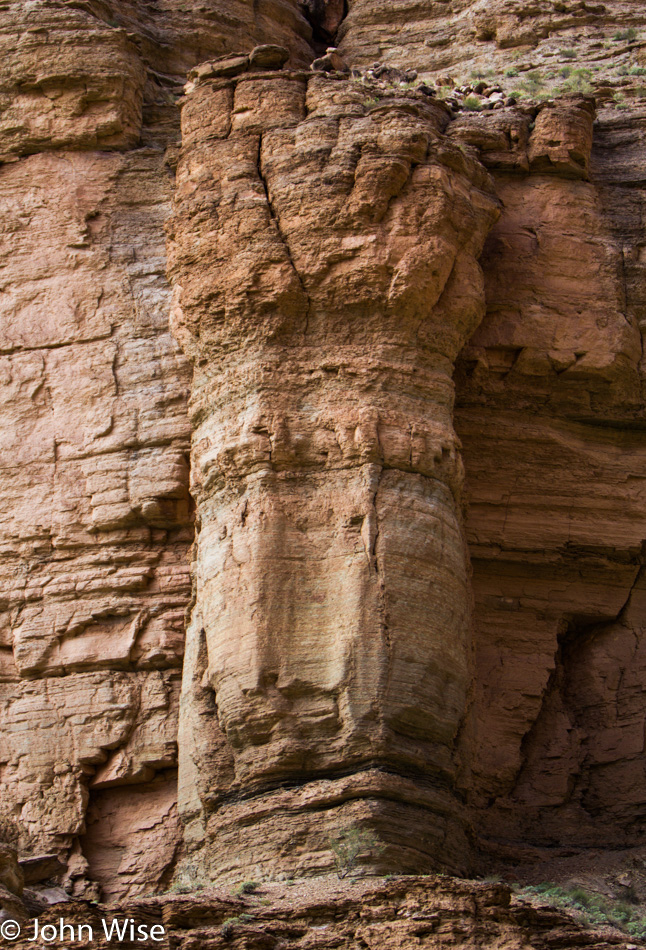

As they were designed to be, the granaries of Nankoweap are nearly impossible to spot from a distance. Even with a person who has visited the Canyon countless times pointing directly at them and accurately describing where to look at the cliff-side, these ancient seed stores remain out of sight. Then, out of the confusion of broken rock and rubble, the pattern of the four – now permanently – open windows is revealed, the regularity standing out as though a spotlight is cast on the granaries. I have admired many a photograph that certainly flatters their beauty, perched high above the Colorado, but the approach from the river below, as we glide by before pulling ashore, offers an appreciation of their veiled location that is hard to convey by word, photo, or film.

The Ancestral Puebloans who chose to live riverside in the desert of the inner Canyon did not stake out the easiest of places to live. Nothing about life down here could have been simple aside from finding intense beauty. Hiking the steep trails between river and rim is hard work. The Colorado would have brought driftwood for fires, but wood to build with would have to have been dragged down from the rim. The rainy season is similar to that of the southwest desert, with heavy monsoonal downpours coming on in July and August when daytime temperatures frequently climb well into the hundreds. After these episodes of torrential rains, the Canyon roars into fury as waterfalls score the cliff-sides and crash with thunderous effects into the river below. Evidence of hundreds of waterfalls can be seen throughout the Canyon. These storms could have damaged trails, made side canyons impassable, and floods may have destroyed crops. Still, the Ancient Ones would persist against this hostile environment for many years before ultimately abandoning the Canyon. Why they left is open to speculation, but some evidence points to an extended period of drought beginning near the year 1150 that appears to have initiated a major migration out of the area.

Part of what they left behind in their departure may be the most photographed and famous granaries in North America; they are found right here, at this bend in the river at mile 52 – Nankoweap. From Little Nankoweap Camp, where we will stay this evening, we track back upriver, passing through another group’s campsite and over a trail that starts out flat but, near the foot of the cliff, changes into a steep scree slope. After ascending the majority of the elevation gain necessary to visit the ruin, the remainder of the trail is a narrow shelf, cutting a switchback up the final yards before we are able to seat ourselves right up in front of these historic granaries.
Here, where I sit on the edge of this cliff-side, at some time in the distant past, another man or woman likely sat after having dragged a part of the harvest to be stored and sealed in this water- and pest-proof, well-camouflaged enclosure. How do I filter the conditioning of modernity to see the world through their eyes? What were the thoughts and feelings of the people who sat here a thousand years before me?
Nankoweap’s four windows into the past now act as reminders of the culture that is long gone. There is no more seed waiting to be planted, no more food to be collected and shared. From below the cliff to the riverside in the distance, the fields that once held crops have long been fallow and will remain so as long as the Grand Canyon is a part of the National Park Service. The Native Americans who visited this corner of the Colorado Plateau for more than 11,000 years left little to help us understand who they were, but as I sit here looking out, I do feel I can know a small part of them. They, too, must have held dear the sense of beauty. Up here, one can see the river continue its timeless flow; canyon walls change color as the day goes by, and shadows chase each other. Unhurried, I embrace the luxury of remaining in the moment, trying to honor and share this humbling recognition of the incredible spectacle nature has created at this bend in the Canyon with those Ancestral Puebloans, in whose home I am a guest.

It is here at Nankoweap that I learn a new reason to appreciate the professionalism of our boatmen. As our group sat next to the granary, a bunch of rafters from a private trip lined up on the trail below us to take our places once we were to depart. That would be a while, as Jeffe was just telling us about the agricultural practices of the Ancestral Puebloans. As we listened, so did the newcomers. It was then that I began to suspect that these travelers likely didn’t have talented storytellers along who would bring the lore, history, and geography of the Canyon to their ears each day and night. How privileged we are to be accompanied by seasoned guides, and how much more may be taken from this journey due to their presence.
Our guides are experts in many small and some large ways, often, this is best evidenced when sharing their knowledge and following in the steps of oral traditions found across time and culture. We are not simply riding the whitewater and hiking; we are being immersed in a totality of experience and wisdom that paints memories with more than the eyes alone can capture. There is no sense of being corralled by teaching lessons; we are free to lend an ear and enjoy learning even more about our temporary home. As we left the granaries, the group that had been waiting patiently thanked Jeffe, each and every one of them, as did we.
How does one get from here to there? Not in the physical sense; I’m referring to the recurring theme of time distortion I keep coming back to. There we were, walking away from Nankoweap on a slow stroll back to camp, lost in conversation, lost in the landscape, lost in history, arriving at who knows what time. Instead of wandering about, following every last ray of light, weary feet, and legs convince the body above them to take a seat next to the crackling fire. The time between sitting down and having dinner could have been spent staring into the fire, admiring the sunset, talking, writing, or hovering near the kitchen, watching the preparation of our evening meal. Whatever it was that kept my attention also captured my sense of time; ate it whole, as a matter of fact. Was it the unimaginable scale of the environment around me, the distance of time stretching into antiquity, or the magnitude of history on display? I can’t be certain which distraction was the culprit, but I do know that from the point when I sat down until after dinner, my mind took an exit from the overwhelming to enjoy the quiet of being still.

Next thing I know, Kenney is reading for us “The Muffler and the Law” from David Lee’s book of poems titled The Porcine Canticles. The poem tells the story of a pig farmer on his way to a hog auction in a truck with a busted muffler. He gets pulled over and fined by a humorless police officer but manages to balance the scales of the perceived injustice with the help of his friend’s big black sow, to the chagrin of this officer of the law. Retired State Trooper Steve “Sarge” Alt is the first to succumb to sidesplitting, infectious laughter; sitting next to him, First Light Frank is second to lose his composure. These two guys are soon rolling around in their chairs, laughing uncontrollably, dragging us all right with them. More than once, Kenney is forced to take pause to bring his own laughter down a notch. He finishes the poem to howls and knee slaps.
This would be a hard act to follow under any other circumstances, but here in the Canyon, we are being groomed to accept whatever comes next. Bruce steps right up to grab the reins and our attention. The encore to the humor is a poignant reminder from desert sage Edward Abbey, who delivered the following words as part of a speech to environmentalists in Missoula, Montana, many a year ago:
“One final paragraph of advice: Do not burn yourself out. Be as I am – a reluctant enthusiast… a part-time crusader, a half-hearted fanatic. Save the other half of yourselves and your lives for pleasure and adventure. It is not enough to fight for the land; it is even more important to enjoy it. While you can. While it is still there. So get out there and mess around with your friends, ramble out yonder and explore the forests, encounter the grizz, climb the mountains. Run the rivers, breathe deep of that yet sweet and lucid air, sit quietly for a while and contemplate the precious stillness, that lovely, mysterious and awesome space. Enjoy yourselves, keep your brain in your head and your head firmly attached to your body, the body active and alive, and I promise you this much: I promise you this one sweet victory over our enemies, over those desk-bound people with their hearts in a safe deposit box and their eyes hypnotized by desk calculators. I promise you this: you will outlive the bastards.”
Bruce wasn’t finished with us yet; he sent us off with a nightcap. He, too, uses a poem, one that he brings out on longer river trips on which the people along for the journey have made a commitment to go further. It’s not everyone who signs up for an 18-day adventure where neither showers, toilets, cozy beds, room service, nor TV is to be found. Those who opt for the convenience of a few days, maybe a week, maybe simply dipping a toe into the waters, or could be collecting quick trophy locations from their bucket list of 100 places to visit in a lifetime. But for the intrepid souls who make the bigger commitment, he brings out an old poet who speaks to the guts of every one of us on this path; that man is Robert Service. Bruce’s selection is from the book The Spell Of The Yukon And Other Verses, published in 1907:
The Call Of The Wild
Have you gazed on naked grandeur
where there’s nothing else to gaze on,
Set pieces and drop-curtain scenes galore,
Big mountains heaved to heaven, which the blinding sunsets blazon,
Black canyons where the rapids rip and roar?
Have you swept the visioned valley
with the green stream streaking through it,
Searched the Vastness for a something you have lost?
Have you strung your soul to silence?
Then for God’s sake go and do it;
Hear the challenge, learn the lesson, pay the cost.
Have you wandered in the wilderness, the sagebrush desolation,
The bunch-grass levels where the cattle graze?
Have you whistled bits of rag-time at the end of all creation,
And learned to know the desert’s little ways?
Have you camped upon the foothills,
have you galloped o’er the ranges,
Have you roamed the arid sun-lands through and through?
Have you chummed up with the mesa?
Do you know its moods and changes?
Then listen to the Wild – it’s calling you.
Have you known the Great White Silence,
not a snow-gemmed twig aquiver?
(Eternal truths that shame our soothing lies.)
Have you broken trail on snowshoes?
mushed your huskies up the river,
Dared the unknown, led the way, and clutched the prize?
Have you marked the map’s void spaces,
mingled with the mongrel races,
Felt the savage strength of brute in every thew?
And though grim as hell the worst is,
can you round it off with curses?
Then hearken to the Wild – it’s wanting you.
Have you suffered, starved and triumphed,
groveled down, yet grasped at glory,
Grown bigger in the bigness of the whole?
“Done things” just for the doing, letting babblers tell the story,
Seeing through the nice veneer the naked soul?
Have you seen God in His splendors,
heard the text that nature renders?
(You’ll never hear it in the family pew.)
The simple things, the true things, the silent men who do things –
Then listen to the Wild – it’s calling you.
They have cradled you in custom,
they have primed you with their preaching,
They have soaked you in convention through and through;
They have put you in a showcase; you’re a credit to their teaching –
But can’t you hear the Wild? – it’s calling you.
Let us probe the silent places, let us seek what luck betide us;
Let us journey to a lonely land I know.
There’s a whisper on the night-wind,
there’s a star agleam to guide us,
And the Wild is calling, calling . . . let us go.
–From my book titled: Stay In The Magic – A Voyage Into The Beauty Of The Grand Canyon about our journey down the Colorado back in late 2010.














